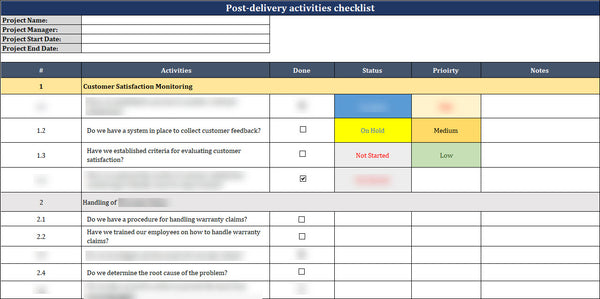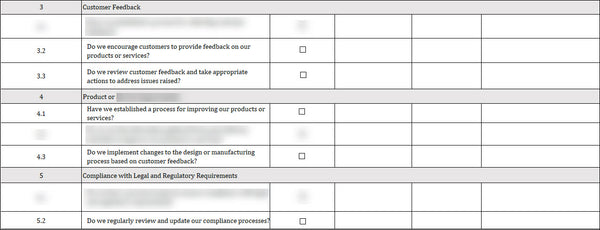ISO 9001 Post-Delivery Activities Checklist Template
ISO 9001 is an internationally recognized standard for quality management systems. It provides guidelines and criteria for organizations to meet customer requirements and enhance customer satisfaction consistently.
One important aspect of ISO 9001 is the post-delivery activities checklist. This checklist outlines the steps organizations should take after delivering a product or service to the customer to ensure that it meets their expectations and that any issues or concerns are addressed promptly and effectively.
In this blog post, we will discuss the key elements of the post-delivery activities checklist in ISO 9001 and why organizations need to implement these practices.

The Importance of Post-Delivery Activities in ISO 9001
- Implementing post-delivery activities by ISO 9001 is crucial for organizations to maintain high-quality standards and customer satisfaction. These activities provide a structured approach to addressing any issues or concerns arising after a product or service has been delivered.
- By following the post-delivery checklist, organizations can ensure customer expectations are met, and problems are resolved promptly and efficiently. This improves customer satisfaction, helps build strong relationships with customers, and enhances the organization's reputation.
- Moreover, post-delivery activities help organizations gather valuable feedback and insights from customers. This feedback can improve processes, products, and services, leading to continuous improvement and delivering better value to customers.
In conclusion, post-delivery activities are integral to ISO 9001 as they enable organizations to monitor and enhance customer satisfaction, resolve issues promptly, and drive continuous improvement. Organizations can establish themselves as trusted providers of high-quality products and services by implementing these activities.
Key Components of Post-Delivery Activities Checklist
As a business, the success of your product or service doesn't end with its delivery to the customer. Post-delivery activities are crucial in ensuring customer satisfaction and maintaining a healthy relationship. To ensure nothing falls through the cracks, it is essential to have a comprehensive post-delivery activities checklist. Here are the key components that should be included in this checklist:
1. Customer Satisfaction Monitoring:
The first component of the checklist should focus on monitoring customer satisfaction. This involves gathering customer feedback to assess their satisfaction level with the delivered product or service. This feedback can be collected through surveys, online reviews, or direct customer communication. By monitoring customer satisfaction, you can identify areas for improvement and make necessary adjustments to meet customer expectations better.
2. Handling of Warranty Claims:
If your product comes with a warranty, it is crucial to have a systematic process in place for handling warranty claims. This checklist component should outline the steps to be taken when a customer reports a warranty issue, including documenting the claim, investigating the problem, providing a resolution, and ensuring customer satisfaction. Effective handling of warranty claims ensures customer confidence in your brand and helps build a reputation for excellent customer service.
3. Customer Feedback:
In addition to monitoring customer satisfaction, actively seeking customer feedback is another essential post-delivery activity. Encourage customers to provide feedback on their experience with your product or service through various channels, such as online review platforms, feedback forms, or direct communication. This feedback can provide valuable insights into customer perceptions, identify strengths and weaknesses, and guide improvements in your offering.
4. Product or Service Improvement:
To stay competitive in the market, continuous improvement is vital. This checklist component should focus on collecting feedback and analysing it to identify areas where your product or service can be enhanced. Whether addressing specific customer needs, adding new features, or improving existing ones, a well-defined product or service improvement process ensures that you stay ahead of the competition and meet evolving customer demands.
5. Compliance with Legal and Regulatory Requirements:
Post-delivery activities should also include a check for compliance with legal and regulatory requirements. This includes ensuring that your product or service meets safety standards, consumer protection laws, or other applicable regulations. Regular audits and assessments should be conducted to ensure ongoing compliance and adherence to standards set by relevant authorities.
In conclusion, post-delivery activities are critical to any business's success. By following a comprehensive checklist that includes customer satisfaction monitoring, handling warranty claims, collecting customer feedback, focusing on product or service improvement, and complying with legal and regulatory requirements, you can ensure that your customers are satisfied, and your brand reputation grows. Your business thrives in the long run.

Monitoring and Improving Post-Delivery Processes
After implementing post-delivery activities by ISO 9001, organizations need to continuously monitor and improve their post-delivery processes. This ensures the organization's efforts to maintain high-quality standards and customer satisfaction are practical and efficient.
Monitoring post-delivery processes involves regularly evaluating the effectiveness of the implemented activities in addressing customer concerns and resolving any issues that may arise. This can be done by analyzing customer feedback, conducting internal audits, and tracking key performance indicators. By closely monitoring these processes, organizations can identify areas for improvement and make necessary adjustments to enhance their post-delivery activities.
In addition to monitoring, organizations must also focus on continuously improving their post-delivery processes. This involves conducting root cause analysis to understand the underlying factors contributing to issues or concerns. Based on the findings, organizations can implement corrective actions to prevent similar issues from occurring in the future. Regularly reviewing and updating the post-delivery checklist is also important to ensure it remains relevant and effective in meeting customer expectations.
By diligently monitoring and continuously improving post-delivery processes, organizations can enhance their ability to deliver high-quality products and services while maintaining customer satisfaction and complying with ISO 9001 standards.
Conclusion
In conclusion, implementing post-delivery activities according to ISO 9001 standards is essential for organizations to ensure customer satisfaction and maintain high-quality standards. Monitoring and improving post-delivery processes play a crucial role in achieving these goals.
By regularly evaluating the effectiveness of implemented activities and analyzing customer feedback, organizations can identify any issues or concerns and take necessary corrective actions. Conducting internal audits and tracking key performance indicators further aid in monitoring post-delivery processes.
Continuous improvement is also vital in enhancing post-delivery activities.
Organizations can prevent recurring issues and improve customer satisfaction by conducting root cause analysis and implementing corrective actions.
Regularly reviewing and updating the post-delivery checklist keeps it relevant and effectively meeting customer expectations.
By prioritizing monitoring and improvement, organizations can ensure the delivery of high-quality products and services while complying with ISO 9001 standards, leading to long-term success and customer loyalty.


